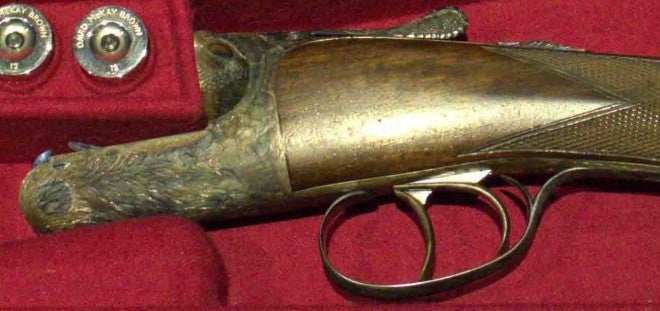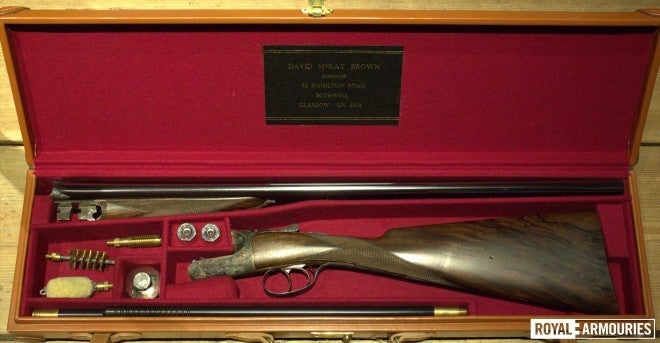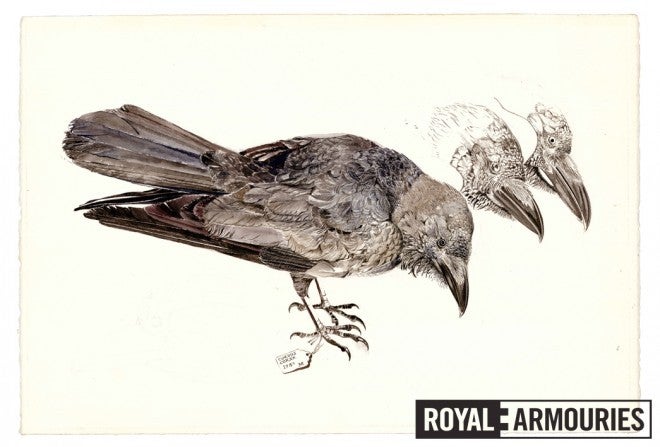The Royal Armouries is one of the oldest museums in the world, and is best known for its collection of antique arms and armour. However, we have always collected modern firearms. The Armouries at the Tower of London was an issuing arsenal from the days of King Henry VIII, stocked with everything from the latest equipment to obsolete weapons kept in reserve. Henry and his successors also commissioned new and experimental weapons which were trialled and then stored at the Tower, becoming curiosities for later museum visitors. Materiel taken in battle from Britain’s enemies was also displayed soon after its capture. Meanwhile, at the Royal Small Arms Factory at Enfield, the Pattern Room collected contemporary (legacy and cutting edge) firearm designs of all kinds in its capacity as a reference collection, a function that is still carried out today by the National Firearms Centre at the Armouries in Leeds.
In the mid-Eighties, the Armouries took the decision to revive the tradition of commissioning new pieces for the collection, with the intention of showcasing the modern art of the gunmaker and to preserve examples of it for future generations. Three unique firearms were completed, including a Smith and Wesson revolver decorated by famous American jewellers Tiffany & Co., and an enormous 2-gauge rifle by gunmaker Giles Whitthome. The first to be ordered, back in October 1984, was the beautiful ‘Raven Gun’.
It was inspired by the famous ravens of the Tower of London, who according to legend would signal the fall of the Tower (and by implication Britain itself) if they were ever lost. It is said that King Charles II ordered their wing feathers trimmed to prevent that ever happening! In reality, the history of the Tower ravens may not be much older than the design of the gun itself, and the apocalyptic story seems to have been created during the Second World War. Nonetheless, these beautiful (and frequently misunderstood) birds are now forever linked with the Tower and are visited by millions of people every year. They are cared for by a Yeoman Warder (‘Beefeater’) Ravenmaster, and even hold military ranks!
It might seem strange to create a gun in honour of a family of birds that might usually be on the receiving end of its shot, but in fact firearms have been used to protect the Tower ravens from their corvid relatives like Carrion Crows and Jackdaws, who are thought to be a disease risk to the larger birds and might also steal their food.
The Raven Gun itself is a double-barrelled hammerless ejector shotgun with a patented ‘round-action’ mechanism that cocks on closing. It is a late Victorian design developed by Edinburgh gunmakers John Dickson & Son and patented between 1880 and 1887. Thousands of these top-notch sporting guns were produced 1960s. The company is still going today, and is once again producing the Dickson round action guns for those able to afford them. However, our special example is the work of another British gunmaker, David McKay Brown, who established his own business after an apprenticeship to Alex Martin of Glasgow in 1957.
The gun’s 27” ‘chopper lump’ barrels are of blacked Sheffield steel with 2 ¾” chambers and a silver bead foresight. The metalwork is blued and blue-black case-hardened, and the stock is of chequered French walnut. What makes the gun really special is the detailed engraving of raven’s feathers. Head-feathers cover the action, eye plumage is used on the breeches, the trigger guard has overlapping feather decoration, and even the top lever and sliding safety are feathered, including a single golden feather and representation of the Tower itself, also in gold. The tang is engraved ‘ARMOURIES’.
This unique decoration was applied by noted artist and engraver Malcolm Appleby, a graduate of the Royal College of Art who has specialised in firearm decoration but whose other work can be found in the Victoria & Albert Museum and National Museum of Scotland, amongst others. Appleby used a taxidermied raven specimen provided by the University of Aberdeen as his reference.
He then used his own drawings as reference to work out which feather patterns would best fit different parts of the gun (you can see more of this process on the Armouries website).
The finished gun was presented in 1986, and placed on display with a museum number of XII.5483. When the majority of the collection moved to Leeds in 1997, the gun moved with it to feature in the museum’s Hunting Gallery, but today it is back on display in the White Tower at the Tower of London, its natural home, alongside the birds that inspired it.
References
Wilson, G.M., ‘The Raven Gun’. Park Lane Arms Fair 4 (1987), p23-25
Tate, D. 2004: British Gun Engraving, Safari Press.
Weblinks
Dickson & Son on their ’round action’ design –http://www.dicksonandmacnaughton.com/gunroom/new_guns/side_by_side/dickson_round_action.aspx
The Armouries at the Tower of London-
http://www.royalarmouries.org/visit-us/tower-of-london
The Ravens at the Tower-
http://www.hrp.org.uk/toweroflondon/stories/theravens
The National Firearms Centre-
http://www.royalarmouries.org/what-we-do/research/nfc
 Your Privacy Choices
Your Privacy Choices




